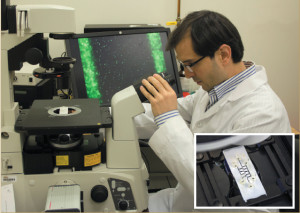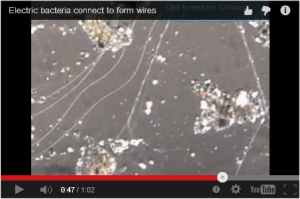Researchers are using genetically engineered E. coli to power micromotors, with the swimming bacteria causing the motors to rotate in a similar fashion to a river rotating a watermill.
 The estimated total number of bacteria of the planet is estimated at five nonillion, and the world of bacteria is stocked with potential, including electrical production.
The estimated total number of bacteria of the planet is estimated at five nonillion, and the world of bacteria is stocked with potential, including electrical production.
Researchers from the University of California are looking to tap into some of that potential by looking at “electrogenic” bacteria, which generate current as part of their metabolism. The research team has found a new way to mimic that ability upon non-electrogenic bacteria, opening up opportunities for new developments in sustainable electricity generation and wastewater treatment.
“The concept here is that if we just close the lid of the wastewater treatment tank and then give the bacteria an electrode, they can produce electricity while cleaning the water,” says Zach Rengert, co-first author of the study. “And the amount of electricity they produce will never power anything very big, but it can offset the cost of cleaning water.”
Wound-healing Technology to Beat Drug-resistant Infections
Posted on November 29, 2016 by Amanda Staller By using mild electric current, a team of researchers from Washington State University has demonstrated the ability to beat drug-resistant bacterial infections – a technology with the potential to treat chronic wound infections.
By using mild electric current, a team of researchers from Washington State University has demonstrated the ability to beat drug-resistant bacterial infections – a technology with the potential to treat chronic wound infections.
Lead by ECS member Haluk Beyenal, the team combined an antibiotic with electrical current to kill the highly persistent Pseudomonas aeruginosa PAO1 bacteria. That very same bacteria can seen in infections of the lung, cystic fibrosis, and even chronic wounds.
“I didn’t believe it. Killing most of the persister cells was unexpected,” Beyenal says. “Then we replicated it many, many times.”
The 21st century has brought new light to strains of antibiotic-resistant bacteria. In many cases, this bacterial resistance is caused by the widespread use of antibiotics in the 20th century. According to the Centers for Disease Control, at least 23,000 deaths per year are attributed to antibiotic-resistant bacterial infections.
Concrete is the world’s most popular building material, but the material’s durability deteriorates over years allowing for potentially devastating consequences. One researcher from Delft University of Technology, Henk Jonkers, has made it his mission to combat this issue by developing a “living concrete.”
Jonkers’ development has produced a new type of concrete that can fix its own cracks by using a bacteria healing agent.
“We are combining nature with construction materials,” said Jonkers.

ECS student member Alireza Mahdavifar observes live bacteria moving inside the microfluidic channel.
Image: Georgia Tech/The Poultry Site
Along with a team of researchers out of Georgia Tech, ECS student member Alireza Mahdavifar has designed and fabricated the prototype of a microfluidic device that exploits cell movement to separate live and dead bacteria during food processing.
The research, entitled “A Nitrocellulose-Based Microfluidic Device for Generation of Concentration Gradients and Study of Bacterial Chemotaxis,” has been recently published in the Journal of The Electrochemical Society.
The new development consists of a microfluidic device that exploits cell movement to separate live and dead bacterial during food processing. The device is novel due to the fact that while screening for foodborne pathogens, it can be difficult to distinguish between viable and non-viable bacteria. Mahdavifar and the team out of Georgia Tech responded to this issue by creating a device that can separate live cells from dead ones for real-time pathogen detection.
Here a fascinating piece from NewScientist.com being passed around the home office at the moment.
Stick an electrode in the ground, pump electrons down it, and they will come: living cells that eat electricity. We have known bacteria to survive on a variety of energy sources, but none as weird as this. Think of Frankenstein’s monster, brought to life by galvanic energy, except these “electric bacteria” are very real and are popping up all over the place.
I love this quote near the end:
The discovery of electric bacteria shows that some very basic forms of life can do away with sugary middlemen and handle the energy in its purest form – electrons, harvested from the surface of minerals. “It is truly foreign, you know,” says Professor Kenneth Nealson. “In a sense, alien.”
There’s a video with the piece that shows the bacteria lassoing food. Watch and read.
Professor Nealson, the focus of this story, has published with us in the past. Read some of his work in The ECS Digital Library.



